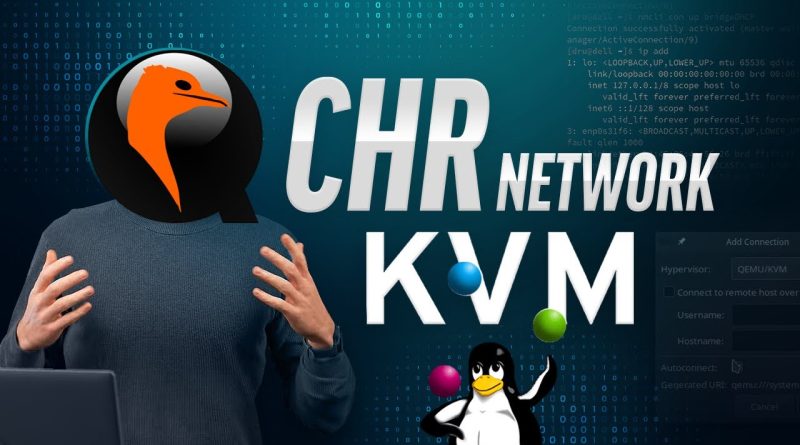Virtual network topology with QEMU/KVM and virt-manager!
Druvis builds an interesting virtual machine setup using the MikroTik CHR images to route traffic for other desktop VMs. What’s more, the virtual network gets bridged to the physical LAN, causing the VMs to become indistinguishable from real devices. Is this a honeypot or a new type of hybrid network? You decide.
by MikroTik
linux dhcp client




please, i have a doubt. To achieve success with this tutorial … need i to use the ethernet cable on my laptop ?
I see that you are using Plasma as your desktop environment. Nice 👍
Nice info, thanks 🙂
I might have a slight issue with your x86 packages. I have a 2xRx100 S7 server and right after booting from usb i get the famous kernel panic not syncing error. I tried removing every pci cards, swapped memory, swapped cpu, swapped both, none of them helped. Tried with different flash drives, in total 12 different one and 2 brand new i purchased for that. Nope, kernel still panics. Used external usb SSD, kernel panic still there. Used Win32 Disk Imager, Rufus and other "burner" software and there is clearly a problem with the image itself and not my servers.
Dear sir I have a problem in mikrotik usermanger
I installed the latest version of RouterOS v7.6 and also interested usermanger package but it is not opening in any browser when I give the IP it says
Error 404: Not Found
планируется ли chr на hyper-v второго поколения?
Manjaro ❤
Can also use GNS3, which makes it so much easier.
Be nice though, if the CHR could be bumped to10Mbit/s. Useless in a provider network, but makes labs much easier to deal with.
please add the src-address field in the wireguard interface for those of us who have multiple WANs to be able to get all the wireguard connections to the same server
Show?
What types of wireless hardware is supported by x86 or CHR? Will it handle Intel AX210 modules with wave2 package, for example?
Server with GUI? You know that does not usually happens. There are virsh, virt-install, etc to do these type of things.
Not for tilera……
Hello Eng Druivs..! you and your video are amazing..all love and repect for you and for Mikrotik..
This makes for a pretty neat solution for setting up LAN party setups as well without needing a lot of additional physical hardware.
Just 1 machine that can do a lot of stuff (router, grafana, steam cache etc.) and some switches (for the tables).
Keeps price down quite a bit.
when will you make?
the tutorial on dual ISP provider load balancing and fail over and separating gaming from browsing and downloading, means a lot if the tutorials came from your youtube channel..
great video.
awesome you tap into that topic!
could you bring up a video for EVE-NG too please?!
i'd love to set up an EVE-NG environment at home and introduce it at work for designing/proofing and basic testing existing and future networks. 🙌💪
Good video 👌 quemu
awesome as usual.. looking forward for the proxmox video.
You guys rock! This is awesome! Thanks! I used to run Manjaro! Also looking forward to the proxmox video as we're probably gonna switch from VMware Esxi to proxmox.
Your videos just rock 🙂
What vNIC do you recommend using for 10G and up ?
what physical NICs do you recommend for a x86 build ? 10G 25G
You can do virtual networks natively in qemu, sure, but more beginner friendly option is GNS3.
Hetzner works great 😀 !
Thank You! A very useful video.
Few hints I can give if it is interesting:
If you want to separate virtual network from real network instead adding multiple isolated networks and interfaces for a simple setup – 1VM network with bunch of hosts in it and a router:
1 BR interface on the host including ETH to real network and ETH to VM router and second BR connected only to VM router as an int interface, than when you are creating new VMs you just add them to the second BR interface of the host. This way you will have easy to manage isolated and routed VM network. From here you can go deeper adding more BR and ether interfaces to VM router to have more isolated networks or you can play with VLANS.
in the end you should end with:
VM router
ether1 – connected to host BR0 (2 interfaces – ethernet card connected to real network and VM card of ther router)
ether2 – connected to host BR1 (1 interface only connected to VM router)
VMxxx with one interface connected to BR1 only
Than all of the other fun – DHCP, routing… etc
It's fun to play with 🙂
Cheers Guys and Lads.
I knew you can isolate virtual networks in libvirt but I had no idea it's that easy. Thank you!
Looing forward to the Proxmox Video